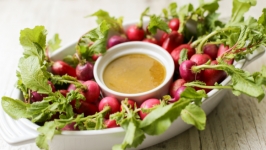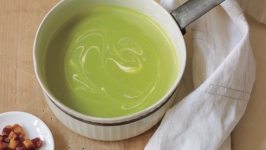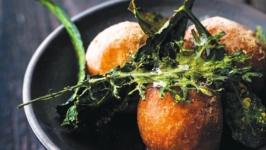Olives the Old World Way, Frantoio Grove
Jeff Martin’s mission can be summed up in a simple sentence: “To make really good olive oil and sell it to my neighbors.” His olives are grown at Frantoio Grove, situated on 30 acres in Gilroy, and it makes for a picturesque landscape. The long, slender leaves of the olive trees glint silver in the midday sun, and a few statuesque cypress trees dot the grove in seemingly random array (more about that later). The scene resembles the Tuscan countryside.
California has been home to olive groves since the mid-1700s, but most of them look nothing like Frantoio Grove. Franciscan monks planted olive trees as they made their way up the coast from Mexico, founding California’s missions. Those trees were primarily Spanish Arbequina variety, which still makes up 78% of the olive trees in the state. They are short and compact, making the olives easy to harvest, and they are extremely hardy in a variety of soil and weather conditions. Arbequina olive oil is known for its buttery, mild taste.
When Martin chose to plant Frantoio Grove, he looked to differentiate his product from other California olive oils. His property is home to 3,500 Tuscan olive trees, most of which are the Frantoio variety. The olive trees are pruned in the old-fashioned style, allowing the branches to spread wide and low, and they are planted much farther apart than Arbequina trees, resulting in a spacious, airy grove. This way, the olives can be picked by hand at the peak of ripeness. No ladders, sticks or automated picking equipment are ever used.
Martin relied on the network of local olive oil producers to set up his grove and press. Purchased from Deborah Rogers at McEvoy Ranch, the olive trees were planted over a day and a half in 2005. In 2007, a heavy freeze damaged many of the trees, but luckily olive trees are a resilient crop. New growth sprouted up from the bases of most of the damaged trees, and Martin was able to train the new growth up the old stalks. Only a handful of trees didn’t survive, and he replaced those with blue cypress trees he happened to have on hand.
The cypress tower noticeably over the olive trees, and many visitors assume that they act as some sort of row markers. While their placement is random, they do serve a useful purpose: acting as perches for the raptors that frequent the grove. The birds help to eradicate voles and other rodents that might otherwise damage the olive trees.
In 2010, Frantoio pressed its first 12 tons of olives. This first pressing was done off-site at Olivina in Livermore, but Martin has since acquired an olive press of his own. He now has full oversight during every step of the process, from growing the olives to pressing, bot- tling, storage and sales.
Frantoio’s most recent crop was picked last fall; the olives’ coloration was an ideal 50/50 ratio of green to black. The handpicked harvest was carefully transported in small crates to avoid damaging the fruit. Each day’s harvest weighed in at a modest five tons, at most. The final harvest for 2013 was 25 tons of olives.
The olive press sits in a building just two miles from the grove, allowing the fruit to be pressed within hours of the harvest. The building was formerly used as a prune dehydrator, and it is a basic facility, running entirely on generator power. The office here consists of a rolling chair and a five-gallon bucket serving as an ottoman. In a small, temperature-controlled room, oil from the recent harvest sits in steel storage tanks topped off with argon gas, ensuring that each shipment can be bottled at peak freshness before it goes to market. Martin plans to build a more elaborate facility, but for now a simple A-frame structure houses his entire operation.
Frantoio Olive Oil is certified extra-virgin by the California Olive Oil Council, and it recently received top honors at the 2014 Good Food Awards. They’ve also collected medals at competitions in Yolo County, Napa County and Los Angeles, where Frantoio Grove bested entrants from all around the world. It can be found in local stores such as Draeger’s and Zanotto’s, and Bi-Rite Market in San Francisco sells it under their private label as “Tuscan Style Olive Oil.”
Buying and storing Olive Oil
The California Olive Oil Council is responsible for awarding the “extra-virgin” designation to oils produced in California. Look for their label to ensure that you are buying a product that has gone through the rigorous lab testing and tasting required for an oil to be called extra-virgin. For a list of the COOC’s approved olive oils, as well as information on where to purchase them, visit COOC.com.
To Taste Olive Oil
Try a range of single-varietal olive oils to find your favorite flavor profile. Pour a small amount of oil into a tasting cup, then cover the cup and swirl to warm the oil and to release its aroma. Take a deep whiff of the oil, and then drink a small sip, pulling it through your teeth to aerate the oil and spread it around your mouth. Finally, swallow the oil and note the finish, which can be peppery or mellow and smooth.
Buy Fresh and Store in a Cool, Dark Place
Olive oil loses pungency the longer it sits on the shelf. Unlike wine, olive oil does not get better with age. Ideally, all packaging would be labeled with a bottling date, but this is not always the case. If you like a very grassy, peppery olive oil, look for the words “Olio Nuovo” (Italian for “new oil”) on bottles sold just after the harvest. This designation is only valid for a short window of time, until the olive oil mellows and is then considered “extra-virgin” for the remainder of its shelf life. Purchase oil bottled in dark-colored glass, and store it in a cool, dark pantry.
Cooking with Olive Oil
Freshly pressed extra-virgin olive oil is at its best when used as a finishing oil to dress salads, pastas and even ice cream. Jeff Martin’s favorite sundae consists of vanilla ice cream topped with olive oil and sea salt. Heating olive oil removes the nuances of the extra-virgin flavor, so while it is fine for cooking, Martin recommends using a less expensive non-extra-virgin oil for sautéing and frying.






